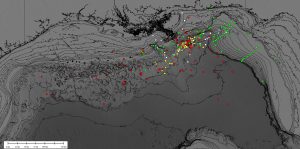Research Footprint Growing in the Gulf of Mexico
– March 10, 2014
Scientists funded through the Gulf of Mexico Research Initiative (GoMRI) have been surveying the Gulf and its marine environment since the Deepwater Horizon oil spill over three years ago.
One ongoing effort is the collection of sediment samples for scientific analyses, advancing the knowledge of seafloor impacts of the Macondo blowout and understanding carbon cycling and microbial dynamics at natural seeps.
Four scientists assembled a map that represents their combined collection sites of sediment samples to date: Samantha Joye (University of Georgia), Arne Diercks (University of Southern Mississippi), Jeff Chanton (Florida State University), and David Hollander (University of South Florida).
These scientists are members of three GoMRI-funded research consortia: Joye and Diercks conduct research with the Ecosystem Impacts of Oil and Gas Inputs to the Gulf (ECOGIG) consortium. Hollander conducts research with two consortia – the Center for Integrated Modeling and Analysis of Gulf Ecosystems (C-IMAGE) and the Deepsea to Coast Connectivity in the Eastern Gulf of Mexico (Deep-C) consortium. And Chanton conducts research with ECOGIG and Deep-C.
On the map, the ECOGIG sampling sites are in red, Deep-C sampling sites are in white, C-IMAGE sampling sites are in green, and National Research Damage Assessment (NRDA) collection sites are in yellow.
Through these various GOMRI-funded efforts, scientists are mapping the distribution of hydrocarbons on the seafloor and documenting their impacts on seafloor fauna, from microorganisms to deepwater corals. To do this, they use sophisticated techniques, such as quantifying the abundance of a naturally occurring carbon isotope, carbon-14 or radiocarbon, which is completely depleted in oil making it a good tracer quantifying content of dispersant and drilling mud residue in the sediment, and measuring the activity and composition of the microbial community.
These studies are advancing the GoMRI research program in its effort to understand the transport and fate of hydrocarbons.
*************
This research was made possible in part by a Grant from BP/The Gulf of Mexico Research Initiative (GoMRI) to the C-IMAGE, Deep-C, and ECOGIG. The GoMRI is a 10-year independent research program established to study the effect, and the potential associated impact, of hydrocarbon releases on the environment and public health, as well as to develop improved spill mitigation, oil detection, characterization and remediation technologies. An independent and academic 20-member Research Board makes the funding and research direction decisions to ensure the intellectual quality, effectiveness and academic independence of the GoMRI research. All research data, findings and publications will be made publicly available. The program was established through a $500 million financial commitment from BP. For more information, visit https://gulfresearchinitiative.org/.
© Copyright 2010- 2017 Gulf of Mexico Research Initiative (GoMRI) – All Rights Reserved. Redistribution is encouraged with acknowledgement to the Gulf of Mexico Research Initiative (GoMRI). Please credit images and/or videos as done in each article. Questions? Contact web-content editor Nilde “Maggie” Dannreuther, Northern Gulf Institute, Mississippi State University (maggied@ngi.msstate.edu).






